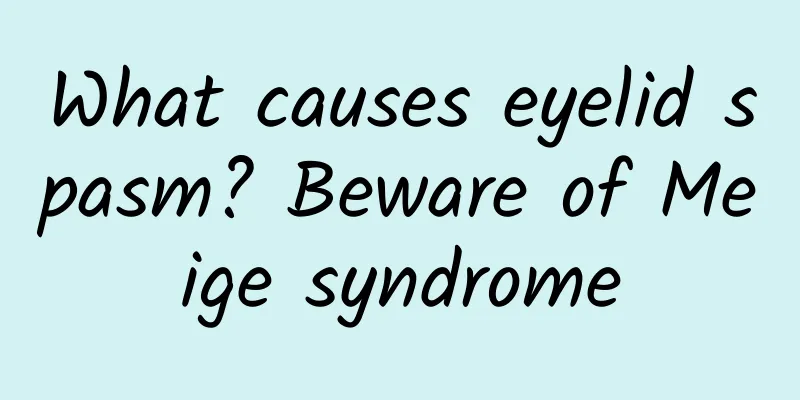What causes eyelid spasm? Beware of Meige syndrome

|
After retiring, 60-year-old Aunt Wu has been helping her two children take turns to look after their granddaughter and grandson in other places, busy from morning till night every day. Three months ago, when she woke up early, she felt a spasm in her eyelids, which gradually disappeared after a few seconds. At first, she didn't take it seriously, but then her eyelids "twitched" more and more, accompanied by symptoms such as difficulty opening her eyes, blurred vision, and facial twitching, as if she was wearing a "mask of pain." When receiving Aunt Wu, Xie Chuncheng, Chairman of the Vertigo Committee of the Heilongjiang Provincial Association of Integrated Traditional Chinese and Western Medicine, Master's Supervisor of the First Affiliated Hospital of Harbin Medical University, and Associate Professor of the Fourth Ward of Neurosurgery, conducted a detailed physical examination and confirmed that the old lady suffered from "Meige Syndrome", commonly known as "blepharospasm". Through a minimally invasive neuromodulation technique performed by experts, combined with taking drugs to relieve dystonia, and mediation through diet and exercise, Aunt Wu's condition has gradually improved. What is Meige syndrome? Xie Chuncheng introduced that Meige syndrome was first reported and described by a French neurologist as a group of extrapyramidal disorders, mainly manifested as eyelid spasm, various forms of dystonia and involuntary movements of facial muscles, mandibular muscles and neck muscles. Nowadays, with fierce competition at work, increased pressure in life, and the accelerated aging of the population, the proportion of sub-healthy people has risen sharply, and Meige syndrome has become commonplace in the elderly. According to a study published in an American journal, the prevalence of Meige syndrome is 5-10/100,000, and most patients are between 40 and 70 years old. There are more women than men, with a male-to-female ratio of 1:3. Although Meige syndrome does not pose a threat to life or cause accidents, the repeated spasms of the eyelids and corners of the mouth cause traction and shaking, which seriously affects the patient's daily speaking, eating, and vision. When walking, the patient often cannot see clearly and falls down. In addition, the facial appearance changes greatly and the expression is abnormal, causing many people to fall into panic, inferiority, and helplessness, and develop stubborn insomnia, anxiety, depression, and other problems. After analyzing the causes, Professor Xie believes that the disease is closely related to factors such as malnutrition, endocrine and metabolic disorders, decreased physical resistance, long-term mental stress, and physical fatigue. From a clinical perspective, Meige syndrome often presents with blepharospasm as the first symptom, and ptosis and eyelid weakness are also common; in some cases, the disease starts in one eye and gradually spreads to both eyes. Other initial symptoms include increased blinking frequency, mental illness, dental diseases, and dystonia of the skull and neck. Dr. Xie Chuncheng pointed out that blepharospasm can be induced or aggravated in situations such as strong light, fatigue, tension, walking, staring, reading, and watching TV, and the spasm state will quickly "ebb" when the mind is relaxed, such as sleeping; and the above clinical phenomena often disappear temporarily like "magic" when yawning, eating, coughing, singing, playing the piano, playing the harmonica, or playing the flute. "Put the brakes on the progression of the disease as early as possible" But no matter what, Meige syndrome will become more serious over time. Some cases may be accompanied by muscle spasm and dystonia, and some people may also develop complications such as ptosis, inability to open the eyes, functional blindness, breathing and swallowing difficulties, and spastic dysarthria. Professor Xie emphasized that at present, Meige syndrome is usually divided into four types by the medical community: blepharospasm type, oromandibular dystonia type, blepharospasm combined with oromandibular dystonia type, and systemic type. The purpose is to deepen understanding and recognition, and take specific intervention measures for different disease types, so as to help "put the brakes on" the course of Meige syndrome as early as possible. Among them, patients with mild blepharospasm show eye discomfort, dry eyes, photophobia, and increased blinking, which are easily misdiagnosed as dry eyes, delaying the disease; patients with slightly more severe symptoms have paroxysmal eye closure and weakness in opening eyes, and need to use fingers to pry open the eyelids; in severe cases, spontaneous spasmodic contraction of the eyes, orbits, and periorbital orbicularis oculi muscles and repeated strong eye closure can lead to functional "blindness", which often causes falls, hitting walls, bumping into people, or knocking out teeth. Xie Chuncheng pointed out that bilateral blepharospasm is a common first symptom, accounting for 76-77% of all cases. Before the spasm occurs, patients often have eyelid irritation, dry eyes, fear of sunlight glare, and frequent blinking. When going out, they must pull up the upper eyelids of both eyes with their hands, and dare not go out alone or cross the road, which brings great inconvenience and pain to their lives. Patients with oromandibular dystonia often open their mouths, clench their teeth, purse their lips, pout their lips, stick out their tongues, etc., with strange and special facial expressions. Severe cases may cause mandibular dislocation and tooth wear, and also significantly interfere with normal vocalization and swallowing functions. When they talk or chew food, they will pull the "trigger" of mouth and mandibular spasms. At the same time, in addition to blepharospasm and abnormal mouth and mandibular muscle tension, about 1/3 of some patients have emotional disorders such as depression, anxiety, obsessive-compulsive personality, schizophrenia, etc. Frequent attacks of facial spasms and related complications can easily induce stroke, coronary heart disease, angina pectoris, and cerebral infarction, especially middle-aged and elderly people with weak constitutions are more likely to be "hit". Combining prevention and treatment to return to normal life Dr. Xie Chuncheng introduced: There are currently three main methods for the treatment of Meige syndrome. The first is to use drugs that can reduce or relieve dystonia, such as diazepam, benzhexol, and high-dose anti-acetylcholine drugs, which are effective for some cases; those with mental changes can take haloperidol, chlorpromazine, etc., and the type of drugs should be gradually adjusted according to the symptoms under the guidance of doctors and pharmacists. The second is local injection of botulinum toxin, which helps to inhibit eyelid twitching and the efficacy can reach more than 90%; but botulinum toxin needs to be repeatedly injected every 3-6 months, and it is easy to develop drug resistance over time and gradually lose its effectiveness. Third, if the first two methods are not ideal, minimally invasive surgery can be considered. Xie Chuncheng's experience is that the deep brain stimulation (i.e. "brain pacemaker therapy") currently used in clinical practice is one of the most significant means to overcome Meige syndrome. The principle is to accurately implant microelectrodes into the relevant nerve nuclei in the brain with the help of stereotactic technology, and connect them to the stimulator buried under the skin of the chest under the clavicle through wires. After that, weak high-frequency electric pulses are emitted, and the nerve nuclei are stimulated by microelectrodes, so that the unbalanced functions between the basal ganglia nerve nuclei loops are corrected, and finally the facial spasm is eliminated. This method is effective for a long time and is not easy to "revive". In daily life, what aspects should we start from to help seek benefits and avoid harm and prevent problems before they happen? Professor Xie suggested: Now is the time when winter and spring are changing, it is suitable to go out of the house, take a walk and exercise; but it is still cold, and the temperature difference between morning and evening is large. When patients with Meige syndrome go outdoors, they need to pay attention to keeping their head and face warm, avoid local moisture, freezing, and cold wind; when at home, they should keep the environment clean and tidy, the air fresh, go to bed early and get up early, and ensure the quality of sleep; at the same time, they should be gentle when brushing their teeth, washing their faces, and taking a bath, and pay attention to the moderate water temperature, which should not be too cold or too hot; three meals a day should avoid strong tea, tobacco and alcohol, eat less fried, spicy, sour and other irritating things, and choose easy-to-chew, soft, and light food, such as eggs, milk, rice porridge and soup, and avoid foods that are prone to allergies. Dr. Xie Chuncheng also warned that middle-aged and elderly people with Meige syndrome need to guard against adverse mental stimulation and not be "kidnapped" by anxiety and depression. He suggested reading more books, watching more news programs, and listening to soft and soothing music every day to relieve mental stress. They can also cultivate hobbies such as painting, calligraphy, chess, singing, and dancing to keep themselves happy. They should also open up their hearts to relatives and friends, communicate sincerely, dilute and release negative emotions, and get out of the shadow of the disease through psychological counseling. About Dr. Xie Chuncheng Doctor, Master's supervisor, and associate chief physician in the Fourth Ward of Neurosurgery, the First Affiliated Hospital of Harbin Medical University. Member of the Vertigo Professional Committee of the Chinese Association of Integrated Traditional Chinese and Western Medicine, Chairman of the Vertigo Professional Committee of the Heilongjiang Association of Integrated Traditional Chinese and Western Medicine, Vice Chairman of the Professional Committee of the Heilongjiang Research Medical Association, and Vice Chairman of the Spinal Cord and Spine Professional Committee of the Heilongjiang Research Hospital Association. |
<<: What are the benefits and functions of navel oranges? How long can a cut navel orange be kept?
>>: Where is the hometown of navel oranges? When do navel oranges in southern Jiangxi ripen?
Recommend
How to take care of your heart and liver scientifically? Come and learn these knowledge
March 18th of each year is the National Liver Pro...
Can I get pregnant after having my cervix removed?
The uterus is an extremely important part of the ...
What fruits are good to eat during the confinement period?
Women's bodies are in a relatively weak state...
What should I do if there are lumps in my breasts when I am weaning? Experts introduce methods!
The so-called weaning refers to the process in wh...
Does farting after ovulation mean pregnancy?
If you want to get pregnant quickly, in fact, as ...
What is postpartum recovery? Professionals to answer!
For any woman, pregnancy and childbirth are very ...
How many days does menstruation usually last?
A normal woman will have her menstrual period eve...
Adjusting the order of eating not only controls blood sugar but also helps lose weight. Come and try it
Speaking of eating order, what do you eat first a...
Symptoms of chronic cystitis in women
We all know that the structure of women's bod...
Photorejuvenation and whitening, let's learn more about it
Many women have spots, acne marks and other defec...
What Chinese medicine should women take to nourish their kidneys?
Kidney deficiency is very common, not only among ...
Don’t worry, pregnant women, there are some tips to achieve painless and comfortable oral treatment!
Author: Wan Kuo, Chief Physician, Peking Union Me...
Can my aunt eat strawberries?
Female friends need to pay attention to their die...
Symptoms of poor liver function in women
We all know that whether men or women, we must pa...









